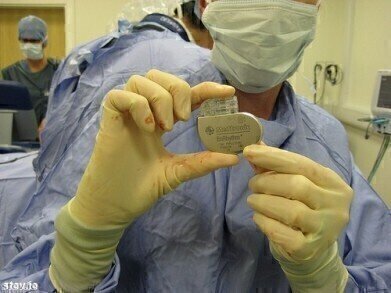-
 New device to treat sleep apnoea
New device to treat sleep apnoea
News
New device to treat sleep apnoea
May 19 2014
A novel device implanted under the skin, much like a pacemaker, is able to successfully treat central sleep apnoea (CSA) in heart failure patients, according to new research.
The study, presented at the Heart Failure Congress 2014 in Athens, Greece, represents the first time that an implantable device has been used to treat the condition in patients that are in heart failure.
CSA is a comorbidity in more than a third (35 per cent) of heart failure patients approximately and doubles their risk of death. Previously, there has been no proven treatment but the new remede system uses unilateral transvenous phrenic nerve stimulation to prevent CSA before it occurs.
Working similarly to a pacemaker, the device is placed under the skin and connected to the veins near the phrenic nerve.
Professor William T. Abraham from Ohio State University, who led the study, said the remede system gave patients more energy and the ability to do their normal daily activities without falling asleep.
He said: "The device stimulates the diaphragm via the phrenic nerve, causing the diaphragm to contract. It regularises the patient's breathing pattern throughout the night, rather than waiting until the patient stops breathing to react."
Some 46 patients were included in the study, all diagnosed with moderate to severe CSA and implanted with the remede system. The pilot study, multicentre trial, found a reduction in apnoea hypopnea index (AHI) at three months compared to baseline with six- and 12-month data also collected.
The one-year results show that the remede system has had substantial benefits for the patients concerning their quality of sleep, including a reduction in AHI, a reduction in the time spent with low blood oxygen levels overnight, and improvements in sleep efficiency and REM sleep.
According to the study, the device also improved important cardiac endpoints such as heart rate variability, which is a measure of autonomic balance. It also found there were other changes to the structure and function of the heart, called reversed remodelling. Patients with the implantable device noted a smaller heart, making the left ventricular diastolic volume significantly smaller and the heart became stronger.
These, according to Professor Abraham, are changes that "generally correlate" with improvement in long-term clinical outcomes.
Digital Edition
Lab Asia Dec 2025
December 2025
Chromatography Articles- Cutting-edge sample preparation tools help laboratories to stay ahead of the curveMass Spectrometry & Spectroscopy Articles- Unlocking the complexity of metabolomics: Pushi...
View all digital editions
Events
Jan 21 2026 Tokyo, Japan
Jan 28 2026 Tokyo, Japan
Jan 29 2026 New Delhi, India
Feb 07 2026 Boston, MA, USA
Asia Pharma Expo/Asia Lab Expo
Feb 12 2026 Dhaka, Bangladesh


















